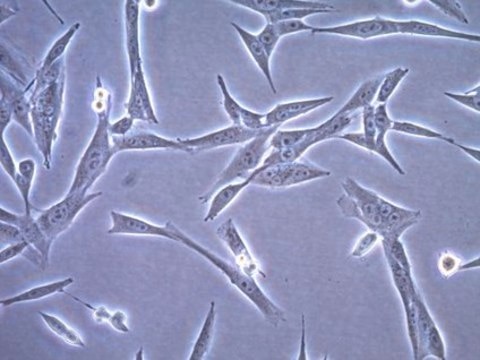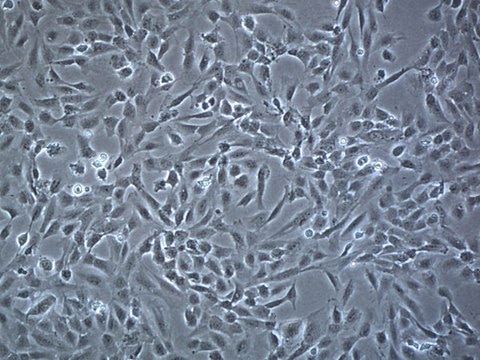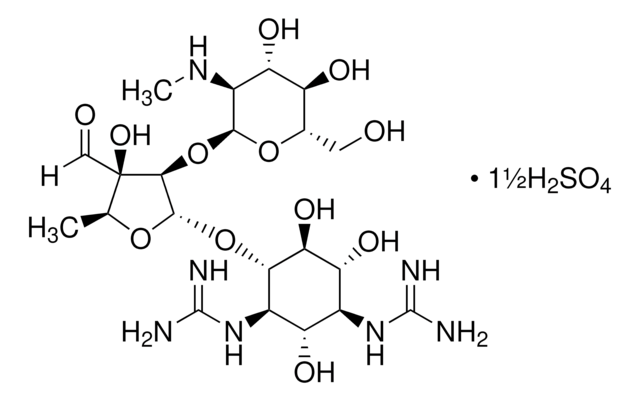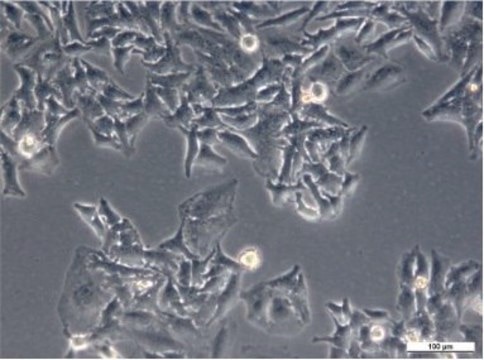SCC194
CT-2A Mouse Glioma Cell Line
CT-2A mouse glioma cell line is a valuable mouse model for therapeutic research on brain malignancies.
Synonym(s):
CT2A
Sign Into View Organizational & Contract Pricing
All Photos(1)
About This Item
UNSPSC Code:
41106514
eCl@ss:
32011203
Recommended Products
biological source
mouse
technique(s)
cell culture | mammalian: suitable
shipped in
ambient
Related Categories
General description
Glioblastomas are among the most aggressive forms of cancer, associated with low treatment efficacy and poor survival. Recurring glioblastomas are often resistant to first-line chemotherapies (1). There is much interest in studying drug-resistant forms of glioblastomas in the effort to develop effective therapies.
References:
1. Weller M, Cloughesy T, Perry JR, and Wick W (2013). Neuro Oncol 15(1): 4-27.
2. Seyfried TN, el-Abbadi M, and Roy ML (1992). Mol Chem Neuropathol 17(2):147-167.
3. Seyfried TN, Mukherjee P (2010). J Oncol 2010:961243 doi.10.1155/2010/961243.
4. Cotterchio M, Seyfried TN (1994). J Lipid Res 35(1): 10-14.
5. Binello E, Qadeer ZA, Kothari HP, Emdad L, Germano IM (2012). J Cancer 3: 166-174.
6. Martinez-Murillo R, Martinez A (2007). Histol Histopathol 22(12): 1309-1326.
7. Zimmerman HM and Arnold H. (1941). Cancer Res 1(12): 919-938.
References:
1. Weller M, Cloughesy T, Perry JR, and Wick W (2013). Neuro Oncol 15(1): 4-27.
2. Seyfried TN, el-Abbadi M, and Roy ML (1992). Mol Chem Neuropathol 17(2):147-167.
3. Seyfried TN, Mukherjee P (2010). J Oncol 2010:961243 doi.10.1155/2010/961243.
4. Cotterchio M, Seyfried TN (1994). J Lipid Res 35(1): 10-14.
5. Binello E, Qadeer ZA, Kothari HP, Emdad L, Germano IM (2012). J Cancer 3: 166-174.
6. Martinez-Murillo R, Martinez A (2007). Histol Histopathol 22(12): 1309-1326.
7. Zimmerman HM and Arnold H. (1941). Cancer Res 1(12): 919-938.
The CT-2A cell line is derived from a sub-cutaneous, non-metastatic murine glioma (astrocytoma). The originating tumor was classified as poorly differentiated with high vascularity and malignancy (2). CT-2A cells are marked by high levels of complex gangliosides and low distribution of the anti-angiogenic ganglioside GM3, as well as deficiency in the tumor suppressor PTEN/TSC2, a characteristic present in up to 70% of human high-grade glioma cell lines (3,4). CT-2A tumors are wild-type for p53 and recapitulate several features of human high-grade glioma, including high mitotic index and cell density, nuclear polymorphism, hemorrhage, pseudopalisading necrosis, and microvascular proliferation (5,6).
Source:
CT-2A was generated from a malignant astrocytoma formed via implantation of the carcinogen 20-methylcholanthrene in the cerebrum of a C57BL/6J mouse (7). The tumor was maintained through serial intracranial transplants prior to cell line isolation.
Source:
CT-2A was generated from a malignant astrocytoma formed via implantation of the carcinogen 20-methylcholanthrene in the cerebrum of a C57BL/6J mouse (7). The tumor was maintained through serial intracranial transplants prior to cell line isolation.
Cell Line Description
Cancer Cells
Application
Research Category
Cancer
Oncology
Cancer
Oncology
This product is intended for sale and sold solely to academic institutions for internal academic research use per the terms of the “Academic Use Agreement” as detailed in the product documentation. For information regarding any other use, please contact licensing@emdmillipore.com.
Quality
• Each vial contains ≥ 1X10⁶ viable cells.
• Cells are tested negative for infectious diseases by a Mouse Essential CLEAR panel by Charles River Animal Diagnostic Services.
• Cells are verified to be of mouse origin and negative for inter-species contamination from rat, chinese hamster, Golden Syrian hamster, human and non-human primate (NHP) as assessed by a Contamination CLEAR panel by Charles River Animal Diagnostic Services.
• Cells are negative for mycoplasma contamination
• Cells are tested negative for infectious diseases by a Mouse Essential CLEAR panel by Charles River Animal Diagnostic Services.
• Cells are verified to be of mouse origin and negative for inter-species contamination from rat, chinese hamster, Golden Syrian hamster, human and non-human primate (NHP) as assessed by a Contamination CLEAR panel by Charles River Animal Diagnostic Services.
• Cells are negative for mycoplasma contamination
Storage and Stability
Store in liquid nitrogen. The cells can be cultured for at least 10 passages after initial thawing without significantly affecting the cell marker expression and functionality.
Disclaimer
Unless otherwise stated in our catalog or other company documentation accompanying the product(s), our products are intended for research use only and are not to be used for any other purpose, which includes but is not limited to, unauthorized commercial uses, in vitro diagnostic uses, ex vivo or in vivo therapeutic uses or any type of consumption or application to humans or animals.
Storage Class
12 - Non Combustible Liquids
wgk_germany
WGK 2
flash_point_f
does not flash
flash_point_c
does not flash
Certificates of Analysis (COA)
Search for Certificates of Analysis (COA) by entering the products Lot/Batch Number. Lot and Batch Numbers can be found on a product’s label following the words ‘Lot’ or ‘Batch’.
Already Own This Product?
Find documentation for the products that you have recently purchased in the Document Library.
Michael Weller et al.
Neuro-oncology, 15(1), 4-27 (2012-11-09)
Newly diagnosed glioblastoma is now commonly treated with surgery, if feasible, or biopsy, followed by radiation plus concomitant and adjuvant temozolomide. The treatment of recurrent glioblastoma continues to be a moving target as new therapeutic principles enrich the standards of
R Martínez-Murillo et al.
Histology and histopathology, 22(12), 1309-1326 (2007-08-21)
Animal models of glial-derived neoplasms are needed to study the biological mechanisms of glioma tumorigenesis and those that sustain the disease state. With the aim to develop and characterize a suitable in vivo experimental mouse model for infiltrating astrocytoma, with
Aleksei A Stepanenko et al.
Molecular therapy oncolytics, 24, 230-248 (2022-01-25)
Ad5-delta-24-RGD is currently the most clinically advanced recombinant adenovirus (rAd) for glioma therapy. We constructed a panel of fiber-modified rAds (Ad5RGD, Ad5/3, Ad5/35, Ad5/3RGD, and Ad5/35RGD, all harboring the delta-24 modification) and compared their infectivity, replication, reproduction, and cytolytic efficacy
M Cotterchio et al.
Journal of lipid research, 35(1), 10-14 (1994-01-01)
The content of serum gangliosides was examined in VM and C57BL/6J (B6) mice that contained subcutaneous metastatic (VM) and non-metastatic (CT-2A) brain tumors, respectively. Gas-liquid chromatography (GLC) and high performance thin-layer chromatography (HPTLC) were used to analyze the serum gangliosides.
Emanuela Binello et al.
Journal of Cancer, 3, 166-174 (2012-04-20)
Evidence has pointed to brain tumor stem cells (BTSC) as culprits behind human high-grade glioma (hHGG) resistance to standard therapy. Pre-clinical rodent models are the mainstay for testing of new therapeutic strategies. The typical model involves the intracranial injection of
Our team of scientists has experience in all areas of research including Life Science, Material Science, Chemical Synthesis, Chromatography, Analytical and many others.
Contact Technical Service




